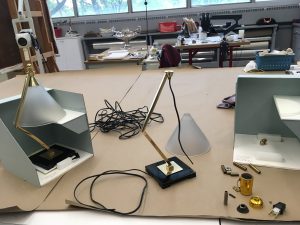Illuminating the Lamps
The museum’s Objects Conservator Kelly Rectenwald channeled an electrician’s skills to make this pair of lamps light up again. Since the lamps lacked their original working parts, Rectenwald installed new wires, sockets, and lightbulbs. Although elegant, the skinny, angled brass stands of these lamps posed a challenge. It was nearly impossible to pull a wire through them.
Rectenwald consulted an electrician to find a wire that was thin enough to fit through the stand but carried enough power to safely light the bulb without overloading. Safety concerns also guided her decision to use an LED lightbulb over an incandescent one: LED bulbs draw much less power, making it safer to use with the lamps’ thin wires. One wonders about the difficulties the lamps’ makers encountered while fabricating this design for Joseph Urban.
Mending the Bedcover

A steady hand and a sharp eye were key for the repair of this painted silk taffeta bedcover. The wavy, light-colored lines on the fabric are places where the silk has pulled apart due to wear and light damage. To repair the bedcover and make it strong enough for display, the museum’s Textile Conservator Chandra Obie Linn applied a thin silk material called crepeline to the back of the original silk with a light, conservation-safe adhesive. The crepeline supports the damaged areas, ensuring that the silk will not fall apart when draped over Elaine’s bed.
Linn then stitched the weakest, split areas of the fabric with a technique called laid thread couching. The stitching ensures that the layers stay together and prevents torn edges from moving. A curved needle is used so the silk can lay flat while it is being stitched: no need to pick up, bend, or handle the delicate material. If you look closely, you can see some lines of the stitching under Linn’s tiny needle.
The Padded Headboard Doppelganger

Using an original object is not always possible. When artworks deteriorate, conservation treatments may no longer be safe to perform. Moreover, objects altered by time may not be the best reflection of an artist’s original intent. We sought to present Joseph Urban’s vision and design for the Wormser Bedroom as much as possible. As a result, some of the works on display are reproductions of damaged or missing originals.
The headboard on display is composed of new and old materials. When the original silk-covered headboard insert came to the textile conservation lab for treatment, it was under tension, soiled, and damaged in a way that was difficult to treat safely and effectively. The museum’s Textile Conservator Chandra Obie Linn decided to substitute the original insert with a new, padded replacement made of conservation-safe materials, which fits snugly into the original headboard frame. This allows the original, unaltered insert to remain safely in storage, while preserving Joseph Urban’s intended look.
The original headboard insert features a heavy wood base covered in cotton batting and silk taffeta, finished with matching piping containing what little is left of a cotton core. Its new clone is archival foamcore covered in resin-free polyester batting and polyester taffeta, finished with matching piping with a cotton core. Although materially different, the insert is visually a near-perfect substitute for the original, which can safely take a break from its long years of service.
Photographing the Bed and Bedcover

As part of this project, the museum’s photographer Rob Deslongchamps properly documented all of the objects from the Wormser Bedroom. In the photo above, the museum’s Textile Conservator Chandra Obie Linn is helping Elaine’s bedcover get ready for its “close up.” Conservators work with photographers and curators to prepare objects for photography, ensuring that images are as flattering and accurate as possible. Here, Linn fixes the drape of the gathered skirt to help it look its best and hide fragile and damaged areas. The painted silk taffeta bedcover has been treated for extensive splitting of the delicate fabric, but you’ll have to look very closely to find any of the fine stitching and patch supports.
